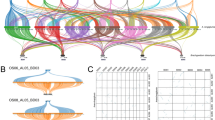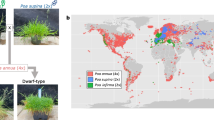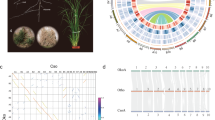Abstract
Brachypodium, a wild temperate grass with a small genome, was recently proposed as a new model organism for the large-genome grasses. In this study, we evaluated gene content and microcolinearity between diploid wheat (Triticum monococcum), Brachypodium sylvaticum, and rice at a local genomic region harboring the major wheat domestication gene Q. Gene density was much lower in T. monococcum (one per 41 kb) because of gene duplication and an abundance of transposable elements within intergenic regions as compared to B. sylvaticum (one per 14 kb) and rice (one per 10 kb). For the Q gene region, microcolinearity was more conserved between wheat and rice than between wheat and Brachypodium because B. sylvaticum contained two genes apparently not present within the orthologous regions of T. monococcum and rice. However, phylogenetic analysis of Q and leukotriene A-4 hydrolase-like gene orthologs, which were colinear among the three species, showed that Brachypodium is more closely related to wheat than rice, which agrees with previous studies. We conclude that Brachypodium will be a useful tool for gene discovery, comparative genomics, and the study of evolutionary relationships among the grasses but will not preclude the need to conduct large-scale genomics experiments in the Triticeae.






Similar content being viewed by others
References
Ahn S, Anderson JA, Sorrells ME, Tanksley SD (1993) Homoeologous relationships of rice, wheat and maize chromosomes. Mol Gen Genet 241:483–490
Altschul SF, Madden TL, Schaffer AA, Zhang J, Zhang Z, Miller W, Lipman DJ (1997) A new generation of protein database search programs. Nucleic Acids Res 25:3389–3402
Bennett MD, Leitch IJ (2005) Nuclear DNA amounts in Angiosperms: progress, problems and prospects. Ann Bot 95:45–90
Bennetzen JL (2000) Comparative sequence analysis of plant nuclear genomes: microcolinearity and its many exceptions. Plant Cell 12:1021–1029
Bossolini E, Wicker T, Knobel PA, Keller B (2007) Comparison of orthologous loci from small grass genomes Brachypodium and rice: implications for wheat genomics and grass genome annotation. Plant J 49:704–717
Catalan P, Olmstead RG (2000) Phylogenetic reconstruction of the genus Brachypodium P. Beauv. (Poaceae) from combined sequences of chloroplast ndhF gene and nuclear ITS. Plant Syst Evol 220:1–19
Catalan P, Ying S, Armstrong L, Draper J, Stace CA (1995) Molecular phylogeny of the grass genus Brachypodium P. Beauv. based on RFLP and RAPD analysis. Bot J Linn Soc 117:263–280
Chantret N, Cenci A, Sabot F, Anderson O, Dubcovsky J (2004) Sequencing of the Triticum monococcum hardness locus reveals good microcolinearity with rice. Mol Gen Genomics 271:377–386
Chuck G, Meeley RB, Hake S (1998) The control of maize spikelet meristem fate by the APETALA2-like gene indeterminate spikelet1. Genes Dev 12:1145–1154
Devos KM, Gale MD (2000) Genome relationships: the grass model in current research. Plant Cell 12:637–646
Distelfeld A, Uauy C, Olmos S, Schlatter AR, Dubcovsky J, Fahima T (2004) Microcolinearity between a 2-cM region encompassing the grain protein content locus Gpc-6B1 on wheat chromosome 6B and a 350-kb region on rice chromosome 2. Funct Integr Genomics 4:59–66
Draper J, Mur LAJ, Jenkins G, Ghosh-Biswas GC, Bablak P, Hasterok R, Routledge APM (2001) Brachypodium dystachyon: a new model system for functional genomics in grasses. Plant Phys 127:1539–1555
Faris JD, Gill BS (2002) Genomic targeting and high-resolution mapping of the domestication gene Q in wheat. Genome 45:706–718
Faris JD, Haen KM, Gill BS (2000) Saturation mapping of a gene-rich recombination hot spot in wheat. Genetics 154:823–835
Faris JD, Fellers JP, Brooks SA, Gill BS (2003) A bacterial artificial chromosome contig spanning the major domestication gene Q in wheat and identification of a candidate gene. Genetics 164:311–321
Feuillet C, Keller B (1999) High gene density is conserved at syntenic loci of small and large grass genomes. Proc Natl Acad Sci USA 96:8265–8270
Feuillet C, Keller B (2002) Comparative genomics in the grass family: molecular characterization of grass genome structure and evolution. Ann Bot 89:3–10
Feuillet C, Penger A, Gellner K, Mast A, Keller B (2001) Molecular evolution of receptor-like kinase genes in hexaploid wheat. Independent evolution of orthologs after polyploidization and mechanisms of local rearrangements at paralogous loci. Plant Physiol 125:1304–1313
Foote TN, Griffiths S, Allouis S, Moore G (2004) Construction and analysis of a BAC library in the grass Brachypodium sylvaticum: its use as a tool to bridge the gap between rice and wheat in elucidating gene content. Funct Integr Genomics 4:26–33
Francki M, Carter M, Byan K, Hunter A, Bellgard M, Appels R (2004) Comparative organization of wheat homoeologous group 3S and 7L using wheat-rice synteny and identification of potential markers for genes controlling xanthophyll content in wheat. Funct Integr Genomics 4:118–130
Gale MD, Devos KM (1998) Comparative genetics in the grasses. Proc Natl Acad Sci USA 95:1971–1974
Griffiths S, Sharp R, Foote TN, Bertin I, Wanous M, Reader S, Colas I, Moore M (2006) Molecular characterization of Ph1 as a major chromosome pairing locus in polyploid wheat. Nature 439:749–752
Hasterok R, Marasek A, Donnison IS, Armstead I, Thomas A, King IP, Wolny E, Idziak D, Draper J, Jenkins G (2006) Alignment of the genomes of Brachypodium distachyon and temperate cereals and grasses using bacterial artificial chromosome landing with fluorescence in situ hybridization. Genetics 173:349–362
International Rice Genome Sequencing Project (2005) The map-based sequence of the rice genome. Nature 436:793–800
Kato K, Miura H, Sawada S (1999) QTL mapping of genes controlling ear emergence time and plant height on chromosome 5A of wheat. Theor Appl Genet 98:472–477
Lagudah ES, McFadden H, Singh RP, Huerta-Espino J, Bariana HS, Spielmeyer W (2006) Molecular genetic characterization of the Lr34/Yr18 slow rusting resistance gene region in wheat. Theor Appl Genet 114:21–30
Lander ES, Green P, Abranhamson J, Barlow A, Daly MJ, Lincoln SE, Newburg L (1987) Mapmaker: an interactive computer package for constructing primary genetic linkage maps of experimental and natural populations. Genomics 1:174–181
Leighty CE, Boshnakian S (1921) Genetic behaviour of the spelt form in crosses between Triticum spelta and Triticum aestivum. J Agric Res 7:335–364
Li W, Gill BS (2002) The colinearity of the Sh2/A1 orthologous region in rice, sorghum and maize is interrupted and accompanied by genome expansion in the Triticeae. Genetics 160:1153–1162
Lu HJ, Faris JD (2006) Macro- and micro-colinearity between the genomic region of wheat chromosome 5B containing the Tsn1 gene and the rice genome. Funct Integr Genomics 6:90–103
MacKey J (1954) Neutron and X-ray experiments in wheat and a revision of the speltoid problem. Hereditas 40:65–180
Muramatsu M (1963) Dosage effect of the spelta gene q of hexaploid wheat. Genetics 48:469–482
Muramatsu M (1986) The vulgare super gene, Q: its universality in durum wheat and its phenotypic effects in tetraploid and hexaploid wheats. Can J Genet Cytol 28:30–41
Paterson AH, Bowers JE, Chapman BA (2004) Ancient polyploidization predating divergence of the cereals and consequences for comparative genomics. Proc Natl Acad Sci USA 101:9903–9908
SanMiguel PJ, Ramakrishna W, Bennetzen JL, Busso C, Dubcovsky J (2002) Transposable elements, genes and recombination in a 215-kb contig from wheat chromosome 5Am. Funct Integr Genomics 2:70–80
Schnurbusch T, Collins NC, Eastwood RF, Sutton T, Jefferies SP, Langridge P (2007) Fine mapping and targeted SNP survey using rice-wheat gene colinearity in the region of the Bo1 boron toxicity tolerance locus of bread wheat. Theor Appl Genet 115:451–461
Sears ER (1954) The aneuploids of common wheat. MO Agr Exp Sta Res Bull 572:1–59
Simons KJ, Fellers JP, Trick HN, Zhang Z, Tai Y-S, Gill BS, Faris JD (2006) Molecular characterization of the major wheat domestication gene Q. Genetics 172:547–555
Sorrells ME, La Rota M, Bermudez-Kandianis CE, Greene RA, Kantety R, Munkvold JD, Miftahudin, Mahmoud A, Ma X, Gustafson PJ, Qi LL, Echalier B, Gill BS, Matthews DE, Lazo GR, Chao S, Anderson OD, Edwards H, Linkiewicz AM, Dubcovsky J, Akhunov ED, Dvorak J, Zhang D, Nguyen HT, Peng J, Lapitan NLV, Gonzalez-Hernandez JL, Anderson JA, Hossain K, Kalavacharla V, Kianian SK, Choi DW, Close TJ, Dilbirligi M, Gill KS, Steber C, Walker-Simmons MK, McGuire PE, Qualset CO (2003) Comparative DNA sequence analysis of wheat and rice genomes. Genome Res 13:1818–1827
Stein N (2007) Triticeae genomics: advances in sequence analysis of large genome cereal crops. Chromosome Res 15:21–31
Tatusova TA, Madden TL (1999) BLAST 2 Sequences: a new tool for comparing protein and nucleotide sequences. FEMS Microbiol Lett 174:247–250
Valarik M, Linkiewicz AM, Dubcovsky J (2006) A microcolinearity study at the earliness per se gene Eps-A m 1 region reveals an ancient duplication that preceded the wheat-rice divergence. Theor Appl Genet 112:945–957
Van Deynze AE, Dubcovsky J, Gill KS, Nelson JC, Sorrells ME, Dvorak J, Gill BS, Lagudah ES, McCouch SR, Appels R (1995a) Molecular-genetics maps for group 1 chromosomes of Triticeae species and their relation to chromosomes in rice and oat. Genome 38:45–59
Van Deynze AE, Nelson JC, Yglesis ES, Harrington SE, Braga DP, McCouch SR, Sorrells ME (1995b) Comparative mapping in grasses. Wheat relationships. Mol Gen Genet 248:744–754
Vogel JP, Garvin DF, Leong OM, Hayden DM (2006a) Agrobacterium-mediated transformation and inbred line development in the model grass Brachypodium distachyon. Plant Cell Tissue Organ Cult 85:199–211
Vogel JP, Gu Y-Q, Twigg P, Lazo GR, Laudencia-Chingcuanco D, Hayden DM, Donze TJ, Vivian LA, Stamova B, Coleman-Derr D (2006b) EST sequencing and phylogenetic analysis of the model grass Brachypodium distachyon. Theor Appl Genet 113:186–195
Ware DH, Jaiswal P, Ni J, Yap IV, Pan X, Clark KY, Teytelman L, Schmidt SC, Zhao W, Chang K, Cartinhour S, Stein LD, McCouch SR (2002) Gramene, a tool for grass genomics. Plant Physiol 130:1606–1613
Yan L, Loukoianov A, Tranquilli G, Helguera M, Fahima T, Dubcovsky J (2003) Positional cloning of wheat vernalization gene VRN1. Proc Natl Acad Sci USA 100:6263–6268
Acknowledgments
This research was supported by USDA-ARS CRIS project 5442-22000-030.
Author information
Authors and Affiliations
Corresponding author
Rights and permissions
About this article
Cite this article
Faris, J.D., Zhang, Z., Fellers, J.P. et al. Micro-colinearity between rice, Brachypodium, and Triticum monococcum at the wheat domestication locus Q . Funct Integr Genomics 8, 149–164 (2008). https://doi.org/10.1007/s10142-008-0073-z
Received:
Revised:
Accepted:
Published:
Issue Date:
DOI: https://doi.org/10.1007/s10142-008-0073-z




